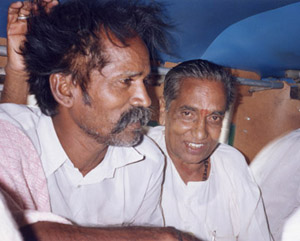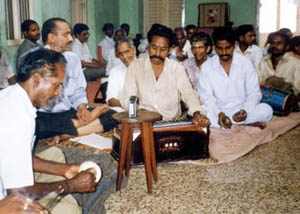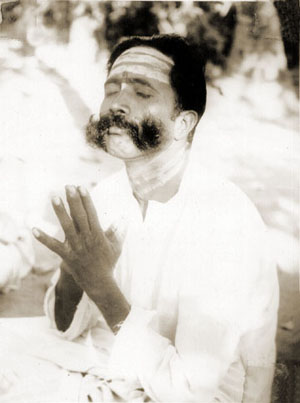SOUL CONNECTIONS HOME | PREVIOUS PAGE | NEXT PAGE

Top: Bhadra Rao. Above: Bhadra Rao with Hindi Master (1994). Below: Bhadra Rao, on the far left, playing cymbals with the Adivarapupeta bhajan group (1997).

Kaleakanda Bhadra Rao
A Childhood Playmate of Swamiji
Visitors to Adivarapupeta would have seen Bhadra Rao at the ashram, often joining the bhajan group lead by his brother, Ramlingeshwara Rao. The same age as Shivabalayogi, Bhadra Rao and Sathyaraju (Swamiji’s name as a child) were childhood playmates. Bhadra Rao passed away in June of 2013.
![]()
Bhadra Rao used to go to the village school with Sathyaraju. They were in the same class because Bhadra Rao was only fifteen days older than Sathyaraju.
They had one teacher who used to sleep during class. This man used to ask his students to twist rope for him. They had to twist coconut fibers into rope which the teacher would use for himself, whether making slings or nets or some other purpose. The teacher used his students for free labor and Swamiji didn’t like it.
One day the teacher told Sathyaraju to twist rope. He did it and when he was all finished and the rope was fully twisted and under pressure, he released it and let it unravel. All the coconut fibers twisted into a useless bunch. The teacher shouted at him a lot, but never again did he give him that work to do.
Another day, this teacher was sleeping in class. He wore his hair in a short pigtail. Swamiji sneaked behind him and used some of the rope to tie the pigtail to the chair in which the teacher was dozing. Then he told the other students, “If anyone tells the master who did this, I will take care of them.”
After a while, the master got up and started walking and found that the chair was following him. Although no one told him who did it, he knew that only Sathyaraju could have played the prank.
The school masters would abuse their positions not only by having the students twist coconut rope, but they would also demand that the students bring them certain things from home like weaving tools or vegetables from the home garden. Those who failed to comply would get beaten with a cane. Even the canes were being supplied by the students. Those students who wanted to be in well with the master would bring him such bribes.
Once Swamiji warned the others that from then on, no one was to bring the master any canes. At the time there were three canes around the school and Sathyaraju broke each one and threw away the pieces. Despite his warnings, one student brought a new cane a few days later and the master used it to beat Swamiji. That evening Swamiji beat up the boy who had brought the cane.
![]()
The children used to steal raw mangos from the tree in the landlord’s garden. The gardener would complain to his master that the children were stealing the fruit and Sathyaraju came to know about the gardener’s complaints. The next day he brought some tobacco leaves with him and started chatting with the gardener. He offered the leaves to the gardener saying that he should roll them into a cigarette to smoke. The gardener happily accepted and was enjoying his smoke and chat.
Beforehand, Sathyaraju had made arrangements with his friends that they could pluck the mangos while he kept the gardener occupied. So while the gardener was smoking and chatting, the other children were picking off all the mangos. When they were done, they gave Sathyaraju a signal who then politely took his leave of the gardener.
The gardener was in a fix. He couldn’t complain to the master about the children because he risked getting punished for being there at the time and having allowed them to take the fruit. The gardener was employed to protect the garden and he allowed the boys to take the mangos. How could he explain that he was smoking and chatting the whole time?
![]()
During the early months and years of Shivabalayogi's tapas, Bhadra Rao also used to hear the Omkara, in the afternoons at around twelve. At times, he also used to hear the cobra hissing, the snake that took up residence inside Shivabalayogi's gunny-sack hut to protect him from intruders.
That field where Swamiji sat in tapas, where children were buried, used to be a very dangerous place. If anyone would slip there or get frightened, that person would not live long. The place had that reputation and it actually happened to his sister. She slipped and fell down there and she died within a week. People used to be afraid of going there. This was before Swamiji came and sat in tapas in that field.
![]()
Bhadra Rao’s father, by name Kaleakanda Subbarao, was a very good devotee of Swamiji and the harmonium player in Adivarapupeta’s original bhajan group. He asked Swamiji for a boon. He wanted to die while playing the harmonium and singing Swamiji's name in bhajans. Swamiji jokingly told him yes, that he played the harmonium at the ashram, and that he would also play on the other side for his devotees there.
Some time passed and it was the Sankrati festival which lasts three days. This is a very sacred time. People believe that whoever dies during Sankrati will go to whatever world he or she desires. During this festival, BHadra Rao’s father collapsed while playing the harmonium and singing bhajans to Swamiji. People around tried to revive him by rubbing his head.
At that very instant, Bhadra Rao was in his house and heard someone calling. He went outside and saw nothing. Fifteen minutes later, his sister came running to tell him that their father had collapsed while singing Swamiji's name. By the time Bhadra Rao got there, his father had passed away.



